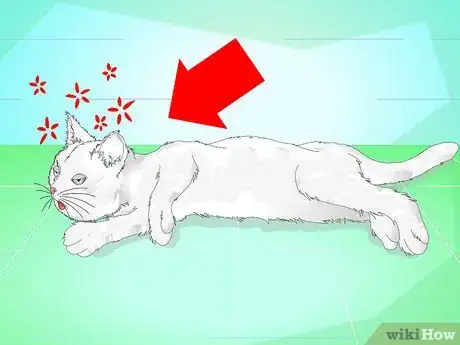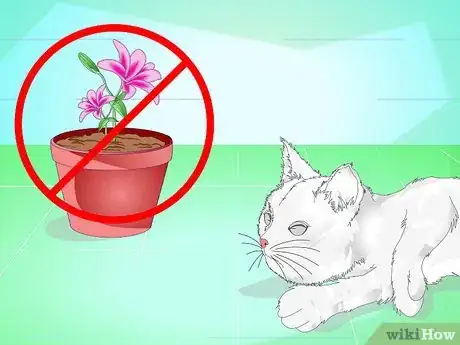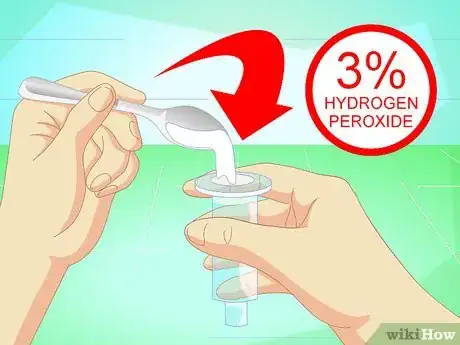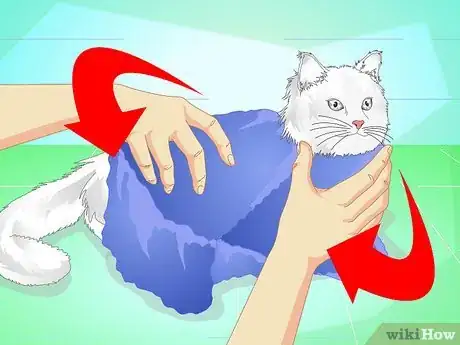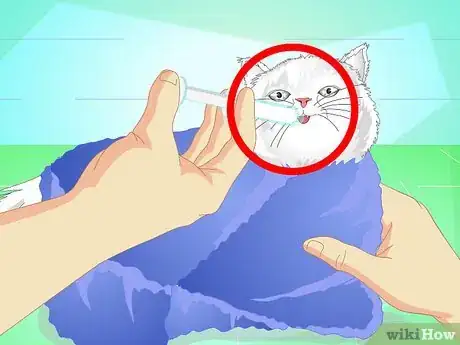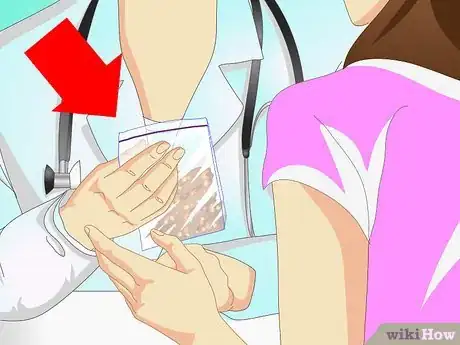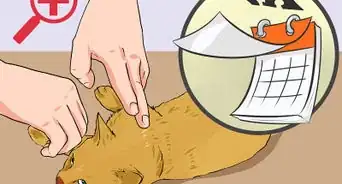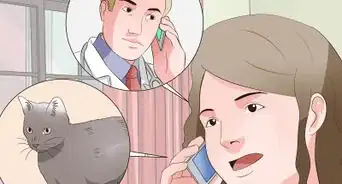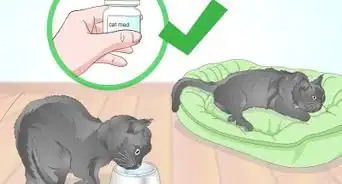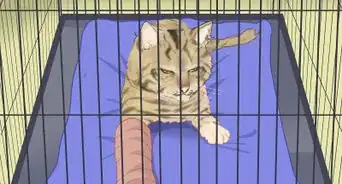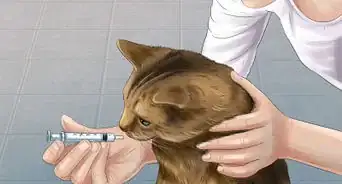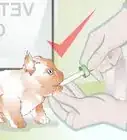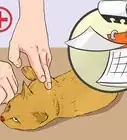This article was co-authored by Pippa Elliott, MRCVS. Dr. Elliott, BVMS, MRCVS is a veterinarian with over 30 years of experience in veterinary surgery and companion animal practice. She graduated from the University of Glasgow in 1987 with a degree in veterinary medicine and surgery. She has worked at the same animal clinic in her hometown for over 20 years.
This article has been viewed 102,535 times.
If your cat has eaten something toxic, your first instinct may be to try and force the cat to vomit and get the toxin out of their system. This is, unfortunately, not easy to do, and is only helpful if the toxin was eaten less than two hours ago. Cats are particularly resistant to the methods of inducing vomiting that may work for dogs — in fact, the only reasonably safe method is to give 3% hydrogen peroxide by mouth (having first checked with your vet it is safe for your cat). If this does not work, or it has been over two hours since the cat ingested the toxin, then you need to go to the vet right away. Warning: Do not give your cat salt in an attempt to induce vomiting, as this can cause kidney damage.
Steps
Assessing Whether Your Cat Should Vomit
-
1Look for signs that your cat has gotten into something dangerous. If you have a cat and you see signs that it has gotten into a toxic substance, find your cat right away. Assess its health as best you can.
-
2Look for causes for sudden illness. Sometimes cats get ingest toxic substances and we don't know it right away. If your cat is acting ill, look around your house and yard for possible items it could have ingested.
- This includes plants that are very toxic to cats. These include a wide variety of indoor and outdoor plants including (but not limited to): aloe, chrysanthemum, dahlia, eucalyptus, and hosta.[1]
Advertisement -
3Contact your veterinarian or poison control center. Contact a veterinarian or a pet poison control center before making your cat vomit. This is important because there are some cases when you should not make your cat vomit, as vomiting might make the situation worse. These cases include:[2]
- If the cat is unconscious or convulsing. Get the cat to the emergency veterinarian immediately if this is happening.
- If the cat has already vomited.
- If the cat has swallowed a sharp object (such as a needle) as vomiting could cause it to get stuck in the lining of the esophagus or stomach.
- If the cat has swallowed any of these substances: an acid, an alkali, household chemicals, or any product containing petroleum.
- It has been more than two hours since the cat ingested the substance.
Making a Cat Vomit
-
1Prepare a vomiting solution. We make cats vomit by feeding them a substance that is irritating, but not damaging, to the stomach. Cats won’t voluntarily take these substances, so they must be carefully forced to ingest it.
- Use 3% hydrogen peroxide. Measure out 1 teaspoon for every 5 pounds, but do not exceed 3 teaspoons. This is given every 10 minutes until the cat vomits, but can only be given a total of three times.[3]
- If the cat does not vomit after this get it to the veterinarian’s office.
- This is the best home remedy to induce vomiting in the cat.
- It will cause foaming in the mouth which is nothing to be concerned about. It may stain or discolor clothing or towels so use an old towel and wear old clothing that you don’t mind possibly discoloring.
-
2Restrain the cat, both for your safety and the safety of the cat. Using a thick, bath-sized towel is the best for this. Unfold the towel and place it on a table or counter top. Pick the cat up and place it in the center of the towel. Pull the towel up over the cat’s hind end, then fold in the sides against the cat, making sure all legs are secured within the towel.[4]
- Do this in a small room with a closed door with no escape or hiding spots where you can’t retrieve the cat.
- Make sure the floor is easy to clean of vomit and any spilled fluid.
-
3Administer the vomiting solution. The best way to give these is by use of a large dropper or a small syringe. A measuring spoon will work in a pinch but plan on wasting some of the fluid. With one person holding the cat securely, pour or administer the solution into the corner of the mouth where there is a gap between the teeth. Slowly and carefully pour in the material waiting for the cat to swallow. You do not want the cat to breathe in the fluid.
- Have someone else help you. You should have one person hold the cat while the other administers the medicine.
- After the dose has been given, hold the cat until it starts to retch and then let it down on the floor to vomit.
-
4Gather the vomit for your veterinarian to inspect. Pick up the vomited material (use a clean dust pan or a paper towel). Place it in a Ziploc bag for your veterinarian to examine during the follow-up examination.
- Call your veterinarian and make an appointment to have the cat examined and for any further follow-up treatments.
Expert Q&A
-
QuestionWhat can cause a cat to throw up?
 Melissa Nelson, DVM, PhDDr. Nelson is a Veterinarian who specializes in Companion and Large Animal Medicine in Minnesota, where she has over 18 years of experience as a veterinarian in a rural clinic. She received her Doctor of Veterinary Medicine from the University of Minnesota in 1998.
Melissa Nelson, DVM, PhDDr. Nelson is a Veterinarian who specializes in Companion and Large Animal Medicine in Minnesota, where she has over 18 years of experience as a veterinarian in a rural clinic. She received her Doctor of Veterinary Medicine from the University of Minnesota in 1998.
Veterinarian There are many things that cause a cat to throw up: eating too fast, a parasitic infection, a stomach or intestinal disease, or a systemic disease. Because there are some many causes, you should see a vet to figure out what is causing your cat to throw up.
There are many things that cause a cat to throw up: eating too fast, a parasitic infection, a stomach or intestinal disease, or a systemic disease. Because there are some many causes, you should see a vet to figure out what is causing your cat to throw up. -
QuestionWhat can cause a cat to throw up?
 Pippa Elliott, MRCVSDr. Elliott, BVMS, MRCVS is a veterinarian with over 30 years of experience in veterinary surgery and companion animal practice. She graduated from the University of Glasgow in 1987 with a degree in veterinary medicine and surgery. She has worked at the same animal clinic in her hometown for over 20 years.
Pippa Elliott, MRCVSDr. Elliott, BVMS, MRCVS is a veterinarian with over 30 years of experience in veterinary surgery and companion animal practice. She graduated from the University of Glasgow in 1987 with a degree in veterinary medicine and surgery. She has worked at the same animal clinic in her hometown for over 20 years.
Veterinarian There are many reasons a cat might vomit. Anything that irritates the stomach lining, such as hairballs or worms, can cause sickness. Also if a cat eats too quickly or has a food sensitivity, this can cause sickness. However, infection and disease can make a cat sick, so if they vomit regularly, always see a vet.
There are many reasons a cat might vomit. Anything that irritates the stomach lining, such as hairballs or worms, can cause sickness. Also if a cat eats too quickly or has a food sensitivity, this can cause sickness. However, infection and disease can make a cat sick, so if they vomit regularly, always see a vet. -
QuestionHow do you induce vomiting on a cat?
 Pippa Elliott, MRCVSDr. Elliott, BVMS, MRCVS is a veterinarian with over 30 years of experience in veterinary surgery and companion animal practice. She graduated from the University of Glasgow in 1987 with a degree in veterinary medicine and surgery. She has worked at the same animal clinic in her hometown for over 20 years.
Pippa Elliott, MRCVSDr. Elliott, BVMS, MRCVS is a veterinarian with over 30 years of experience in veterinary surgery and companion animal practice. She graduated from the University of Glasgow in 1987 with a degree in veterinary medicine and surgery. She has worked at the same animal clinic in her hometown for over 20 years.
Veterinarian The most common home method is to give approximately 1 tsp of 3% hydrogen peroxide by mouth. Other methods are associated with complications. If you know the cat has eaten poison, see a vet right away. They have an injection which makes cats vomit.
The most common home method is to give approximately 1 tsp of 3% hydrogen peroxide by mouth. Other methods are associated with complications. If you know the cat has eaten poison, see a vet right away. They have an injection which makes cats vomit.
Warnings
- All needles, pins, and threads should be stored out of reach of curious cats. Needles threaded with thread or embroidery floss can be accidentally swallowed if a kitten or cat plays with the thread or floss.⧼thumbs_response⧽
- If ever in doubt as to whether or not you should make your cat vomit, consult your veterinarian or a pet poison hotline. Calling a pet poison hotline will generally cost money, but don't let this dissuade you from getting help for your pet if at all possible.⧼thumbs_response⧽
- Keep all household cleaners, garage chemicals, and detergents in closed cabinets that the cat can’t open or gain access too.⧼thumbs_response⧽
References
- ↑ https://www.aspca.org/pet-care/animal-poison-control/cats-plant-list
- ↑ www.vetinfo.com/how-to-induce-vomiting-in-cats.html
- ↑ www.vetinfo.com/how-to-induce-vomiting-in-cats.html
- ↑ www.vspn.org/Library/misc/VSPN_M01158.htm
